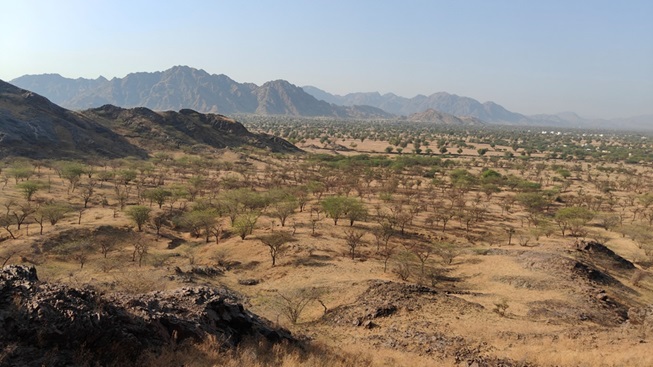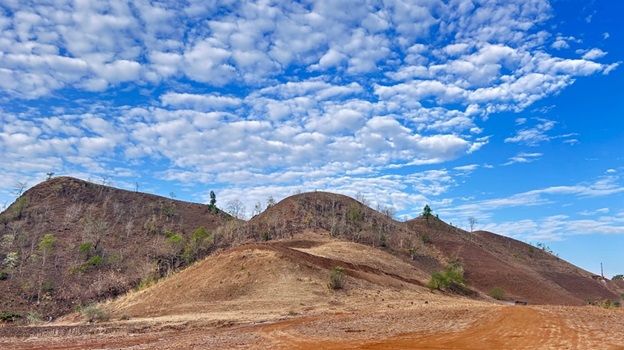RMRE investigation group has been carrying out exploration for the last seven decades in favourable geological domains to establish the resource base of Rare Metals (RM) viz. Niobium (Nb), Tantalum (Ta), Lithium (Li), Beryllium (Be), Cesium (Cs) etc. and Rare Earths (RE) include Lanthanum (La) to Lutetium (Lu) besides Scandium (Sc) and Yttrium (Y). These metals are strategic in nature with wide application in the nuclear and other high-tech industries such as electronics, telecommunication, information technology, space, defense, etc. Presently, AMD is carrying RMRE related investigations from Southern, Eastern, Western and Central Regions.
Geological Occurrence
Important minerals for Rare Metal (RM) are beryl (Be), columbite-tantalite (Nb-Ta), pyrochlore (Nb), spodumene (Li), lepidolite (Li), amblygonite (Li) while Rare Earths Elements (REE) bearing minerals are xenotime (Y and REE), bastnaesite (LREE), monazite (LREE), synchysite (LREE), parasite (LREE), florencite (LREE) etc. Economic concentrations of the RM and REE are mostly confined to the pegmatites, granites, peralkaline and peraluminous volcanics, alkaline–ultramafic rocks, carbonatite complexes, beach and riverine inland placers. Alkaline-ultramafic and carbonatite complexes are the major source of niobium and an increasingly important source of REE. Additionally, other economically-viable REE minerals are also found in placer deposits, iron-oxide copper-gold (IOCG), marine phosphates, and residual deposits from deep weathering of igneous rocks. Columbite-tantalite, beryl, lepidolite, spodumene, amblygonite, etc. generally occur in the pegmatite belts of India in Rajasthan, Bihar, Andhra Pradesh, Karnataka, Odisha, Chhattisgarh, Madhya Pradesh and Tamil Nadu. Monazite occurring in beach sand and teri is the chief source for thorium and REEs in India. Besides, the carbonatites and alkaline rocks of Gujarat, Rajasthan, Tamil Nadu, Assam and Meghalaya are also potential sources for Rare Metal and Rare Earths mineralisation. Xenotime occurs in the riverine placers of Chhattisgarh, West Bengal, Gujarat, Rajasthan and Jharkhand. The brines in playas and salt pans in the arid regions of Gujarat and Rajasthan are favourable sources for lithium.
Summary of Investigations: Important finds
AMD initiated exploration to augment Rare Metal (RM) mainly in the pegmatite belts of Bihar, Andhra Pradesh and Rajasthan since 1950 and identification of several beryl-bearing pegmatites, especially in Bihar and Rajasthan, has been the hallmark of success during the early 1950s. The pegmatite belts are most explored over the last seven decades for RM. Lepidolite, ambligonite, spodumene (Li); beryl (Be); columbite-tantalite, pyrochlore-microlite, ixiolite (Nb-Ta); monazite, xenotime (Y, REE), are the important RM and REE minerals in these pegmatite belts and carbonatite complexes of India. The in situ and eluvial soils, derived from the mechanical weathering of host pegmatites, typically contain rare metal minerals namely columbite-tantalite (niobium-tantalum), beryl (beryllium), spodumene and lepidolite (lithium). As part of prospecting operations, the soil containing these minerals are sampled and processed in the sample collection units established near the source. Besides, handpicking of coarser, discrete minerals and panning of stream sediment and residual soil samples are also carried out to segregate the heavy minerals.
In Allapatna-Marlagalla sector in Mandya district, Karnataka, AMD besides carrying out recovery operations for Nb-Ta mineral and spodumene (Li mineral) from pegmatite gravels, core drilling is also being carried out to establish the depth continuity of the lithium and rare metals. Besides, significant Li-bearing pegmatite rocks have been delineated in Korba district, Chhattisgarh, where survey and prospecting operations are in progress. Prospecting activities and sub-surface exploration in pegmatite in parts of Mangalur Schist Belt in Yadgiri district, Karnataka have brought to light promising Li-mineralisation (spodumene, lepidolite and petalite) in association with Nb, Ta, Cs and Be minerals.
AMD has so far augmented 1,800 tonne (t) Li-oxide and 51t Nb-oxide resource (G-2 level exploration) in Marlagalla, which has emerged as the first pegmatite hosted lithium deposit in India. Further exploration is in progress.
Owing to the rising demand for REE, AMD has intensified REE exploration in the carbonatite complexes, acidic-basic effusive in India. Recent exploration inputs have established that the carbonatite complexes of Ambadongar, Panwad - Kanwant (LREE rich) in Gujarat, per-alkaline granite-rhyolite of Siwana Ring Complex (HREE rich), Barmer, Balotra districts, Rajasthan and Pakkanadu Alkaline Complex in Dharmapuri Shear Zone, Tamilnadu have immense potential for REE and RM mineralisation. In addition, the other alkaline complexes in India such as Sevattur, Tamilnadu ; Sung Valley, Meghalaya ; Samchampi, Assam ; A-type granites of Kanigiri in Prakasam district, Andhra Pradesh and Idar granites of Umedpur, Gujarat also contain appreciable concentration of rare metals viz. Nb, Ta, Y. Xenotime (Y and REE bearing phosphate mineral), is found to be associated with riverine placers in Siri River and Deo River in Chhattisgarh and Jharkhand respectively.
India’s largest carbonatite hosted REE deposit (~1.12 million tonne RE-Oxide) has been established by AMD (G-2 level exploration) in Ambadungar, Chhota Udepur district Gujarat, which is associated with substantial resources of Nb-oxide, V-oxide, Sr-oxide and Ba-oxide.
In Siwana Ring Complex, two (02) alkaline granite hosted and Rhyolite tuff hosted HREE enriched deposits have been established (G-2 level exploration) in Bhatikhera (94,000t RE-Oxide with Nb-oxide and Zr-oxide) and Dantala (74,900t RE-Oxide with Nb-oxide and Zr-oxide) exploration blocks respectively in Siwana Ring Complex, Balotra district, Rajasthan. Few more potential blocks in Siwana Ring Complex namely Ramaniya, Nal, Phulan, Magreshwar and Buriwara are under active exploration.
Present thrust areas for RMRE exploration
Collection of rare metals viz. Nb-Ta, Be and Li minerals incidental to prospecting operations are being carried out in pegmatite country in parts of Nagamangala Schist belt, Mandya district, Karnataka and in domains of Chhottanagpur Granite Gneiss Complex (CGGC) in Jharsuguda district, Odisha. Exploratory drilling is being carried out to probe subsurface continuity of lithium and other rare metals potential in Marlagalla-Allapatna sector, Mandya district, Karnataka. Detailed surveys and core drilling operations are being initiated to explore lithium and other rare metals potential of pegmatites in CGGC domain in Garhtara-Dhangaon areas, Chhattisgarh. For collection of xenotime bearing polymineral concentrate, prospecting activities are in progress in riverine placers around Kunkuri area in Jashpur district, Chhattisgarh.
Sub-surface exploration is being carried out in parts of Dharmapuri Shear Zone to establish the depth continuity of REE-Nb mineralisation associated with the Proterozoic alkaline complex of Pakkanadu, Salem district, Tamil Nadu. Besides, prospecting activities are in progress to delineate rare metal and rare earth potential in Northern part of Pakkanadu area.
Surveys and sub-surface exploration have been intensified to augment resources of REE, Nb, Zr and associated critical minerals in different prospects in Ambadungar and Saidiwasan carbonatite complexes, Gujarat and in Siwana Ring Complex, Rajasthan.

Siwana Ring Complex, Barmer district, Rajasthan |

Drilling operation in Ambadungar, Chhota Udepur, Gujarat |

Panoramic view of Ankeritic plug in Ambadungar south block, Chhota Udepur, Gujarat |